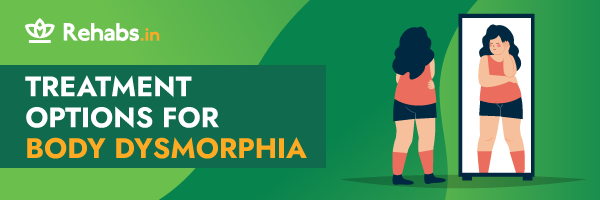Treatment options for body dysmorphia

Body dysmorphia, a mental health condition characterized by a preoccupation with perceived flaws in one’s appearance, can have a significant impact on an individual’s well-being and quality of life. While it is normal to have some insecurities about one’s appearance, body dysmorphia goes beyond that, leading to excessive distress and impairment in daily functioning. Seeking professional help is crucial for effective treatment and recovery from this debilitating condition.
- Accurate Diagnosis:
Body dysmorphia is a complex disorder that requires a proper diagnosis from a qualified mental health professional. They are trained to recognize the signs and symptoms of body dysmorphia and differentiate it from other related conditions or ordinary concerns about appearance. Accurate diagnosis ensures that the appropriate treatment approach is employed.
- Individualized Treatment Plans:
Every person’s experience with body dysmorphia is unique, and a one-size-fits-all treatment approach may not be effective. Mental health professionals, such as therapists and psychiatrists, can assess the severity of the condition and develop personalized treatment plans tailored to the individual’s needs and goals. They take into account factors such as co-occurring conditions, past trauma, and the individual’s support system.
- Evidence-Based Therapies:
Professional help offers access to evidence-based therapies that have been shown to be effective in treating body dysmorphia. Cognitive Behavioral Therapy (CBT) and Acceptance and Commitment Therapy (ACT) are commonly used approaches. These therapies focus on identifying and challenging negative thought patterns, improving body image, and developing healthier coping mechanisms. Mental health professionals are trained in these techniques and can guide individuals through the therapeutic process.
- Medication Management:
In some cases, medication may be recommended as part of the treatment plan for body dysmorphia. Mental health professionals, particularly psychiatrists, are qualified to assess the need for medication, prescribe appropriate medications, and monitor their effectiveness. Medication, such as selective serotonin reuptake inhibitors (SSRIs), can help manage co-occurring anxiety or depressive symptoms that often accompany body dysmorphia.
- Support and Guidance:
Seeking professional help provides a supportive environment where individuals can openly discuss their struggles with body dysmorphia. Mental health professionals offer a non-judgmental space where individuals can express their concerns, fears, and insecurities without fear of ridicule or misunderstanding. They provide guidance, validation, and practical strategies for managing symptoms and improving overall well-being.
- Collaboration and Referrals:
Mental health professionals can collaborate with other healthcare providers to ensure comprehensive care. For example, they may coordinate with dermatologists or plastic surgeons to address specific concerns related to appearance. Additionally, they can provide referrals to support groups, online communities, or adjunctive therapies that can complement traditional treatment approaches.
The journey towards healing from body dysmorphia requires professional help. Mental health professionals play a crucial role in accurately diagnosing the condition, developing individualized treatment plans, providing evidence-based therapies, and offering ongoing support. Seeking professional help is a proactive step towards recovery, allowing individuals to regain control over their lives and cultivate a positive body image. Remember, you don’t have to face body dysmorphia alone—reach out for the support you deserve.
Psychotherapy
Psychotherapy, or talk therapy, is often considered the primary treatment modality for body dysmorphia. It focuses on addressing the underlying thoughts, beliefs, and behaviors associated with the condition. Here are some effective psychotherapeutic approaches commonly used in the treatment of body dysmorphia:
A. Cognitive Behavioral Therapy (CBT):
Cognitive Behavioral Therapy is a widely recognized and evidence-based treatment for body dysmorphia. It aims to identify and challenge the negative thought patterns and cognitive distortions that contribute to body dissatisfaction and preoccupation with perceived flaws. Key components of CBT for body dysmorphia include:
- Identifying Cognitive Distortions
- Exposure and Response Prevention (ERP
- Building Self-Esteem and Coping Skills
B. Acceptance and Commitment Therapy (ACT):
Acceptance and Commitment Therapy is another valuable therapeutic approach for body dysmorphia. It emphasizes acceptance, mindfulness, and aligning actions with personal values. Key components of ACT for body dysmorphia include:
- Mindfulness Techniques
- Values Clarification
- Psychological Flexibility
It’s important to note that psychotherapy for body dysmorphia is typically provided by licensed mental health professionals with expertise in treating the condition. The duration and frequency of therapy sessions may vary depending on the individual’s needs and progress. Additionally, therapists may integrate elements from other therapeutic modalities based on the individual’s unique circumstances.
Medication
While psychotherapy is often the primary treatment for body dysmorphia, medication can be a helpful adjunctive option, especially when there are co-occurring conditions such as anxiety or depression. It is important to note that medication should always be prescribed and monitored by a qualified psychiatrist or healthcare professional. Here are some medication options commonly considered for body dysmorphia:
A. Selective Serotonin Reuptake Inhibitors (SSRIs):
Selective Serotonin Reuptake Inhibitors are a class of antidepressant medications commonly used to treat body dysmorphia. SSRIs work by increasing the availability of serotonin in the brain, which can help alleviate symptoms of anxiety and depression associated with the condition.
B. Other Medications:
In some cases, healthcare professionals may consider other medications beyond SSRIs to address specific symptoms or co-occurring conditions. These medications may include:
- Anti-anxiety Medications
- Mood Stabilizers
- Stimulant Medications
It is important to emphasize that medication should not be viewed as a standalone solution for body dysmorphia. Rather, it should be considered as part of a comprehensive treatment plan that includes psychotherapy and ongoing support. Collaboration between therapists and psychiatrists is vital to ensure coordinated care and the most effective treatment approach for each individual.
Moreover, medication options should be discussed thoroughly with a healthcare professional, weighing the potential benefits against the possible side effects and individual circumstances. Medication dosages may need to be adjusted over time to optimize effectiveness and minimize side effects.
Support groups and peer support
Connecting with others who share similar experiences can provide invaluable emotional support, validation, and a sense of community. Here are some key aspects of support groups and peer support in the context of body dysmorphia:
A. Group Therapy:
Group therapy involves a therapist-led session with a small group of individuals experiencing body dysmorphia. Here’s why group therapy can be beneficial:
- Shared Experiences
- Mutual Support
- Therapist Facilitation
B. Online Communities:
In the digital age, online communities have emerged as a valuable resource for individuals with body dysmorphia. Here’s what to consider when engaging in online peer support:
Access to Support: Online communities, forums, and social media groups provide convenient access to support 24/7. Individuals can connect with others globally, regardless of geographical limitations, and share their experiences, concerns, and triumphs.
C. Adjunctive Therapies and Self-Care:
In addition to traditional therapy and peer support, adjunctive therapies and self-care practices can enhance the treatment of body dysmorphia. These include:
- Body-Focused Therapies
- Self-Care Practices
Remember, while support groups and peer support can be beneficial, they should not replace professional treatment. It is essential to seek guidance from mental health professionals who specialize in body dysmorphia and can provide evidence-based therapies.
Seeking professional help and exploring a personalized treatment plan is a vital step toward healing and recovery from body dysmorphia. It validates your experiences, ensures access to evidence-based therapies, and provides the guidance and support needed to overcome the challenges associated with this condition. Remember, you don’t have to face body dysmorphia alone. Reach out to a qualified mental health professional who can help you develop a personalized treatment plan and support you on your journey toward self-acceptance and a positive body image.You can browse the directory of treatment centers across India here.
Sources:
A Therapist’s Guide for the Treatment of Body Dysmorphic Disorder – BDD. (2014, December 4). BDD. https://bdd.iocdf.org/professionals/therapists-guide-to-bdd-tx/
ACT With CBT for BDD: More Than Alphabet Soup | Anxiety and Depression Association of America, ADAA. (n.d.). https://adaa.org/understanding-anxiety/body-dysmorphic-disorder/treatment/act-with-cbt-for-bdd
Medication Treatment for BDD: FAQ – BDD. (2021, April 2). BDD. https://bdd.iocdf.org/expert-opinions/medication-faq/
NHS. (n.d.-b). Body dysmorphic disorder (BDD). nhs.uk. https://www.nhs.uk/mental-health/conditions/body-dysmorphia/
Phillips, K. A. (2004, February 1). Body dysmorphic disorder: recognizing and treating imagined ugliness. PubMed Central (PMC). https://www.ncbi.nlm.nih.gov/pmc/articles/PMC1414653/














